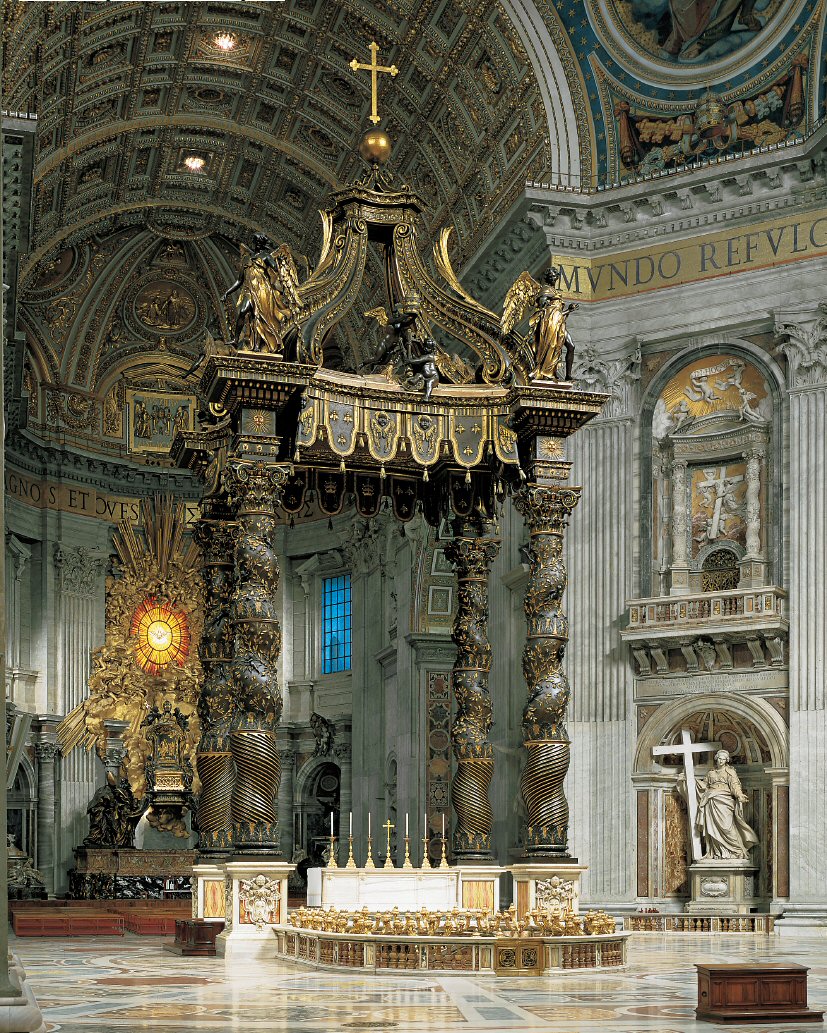We’ve chosen an unusual way to enter the Basilica.What we’ve done is to come up from the foundations, the very cornerstone. Now we are standing in the midst of the greatest monument of sacred architecture ever built. In a sense, it truly “seals” the Apostle’s sepulchre. And as a crowning touch, the cupola by Michelangelo. Taken as a whole, the Basilica is an enormous ciborium or baldachin hovering over Peter’s memorial, with the latter at the focal point of the entire architectonic system. In fact, it is located at the crossing of the longitudinal, transversal and vertical axes of the entire edifice.
One is stunned by the monumental size of this great temple. It was erected during the course of a century (1506 to 1616) and under no fewer than eighteen popes, from Julius II to Paul V. Paul, in fact, put his name on the façade. Even afterwards, such popes as Urban VIII and Alexander VII were still promoting important works inside the Basilica, so that work continued straight through to the middle of the 16th century. The tormented course of this vast project— undertaken and later modified by eleven successive architects—is a fascinating story.
Donato Bramante, one of the founding fathers of Renaissance architecture, drew up the initial plan in 1506. He conceived the basilica in the shape of a Greek cross, to be topped by a cupola whose vertical axis would come directly down to the tomb of the Apostle.
Bramante wished to “place the dome of the Pantheon atop the huge vaulting of the Basilica of Maxentius”. Which is to say, to outdo the most sublime architecture of the classical world in order to glorify Peter. Both Raphael and Giuliano da Sangallo subsequently objected to Bramante’s plan, bringing the designs back to a Latin cross. Antonio da Sangallo perfected the project and made a model in wood of the basilica that is recognizable to us today. In 1545, Michelangelo radically revised Bramante’s plan. The entire edifice, he reasoned, should be like a pedestal for a vast dome that would stand forth from a lofty tambour.
The conception of a curved cupola was transformed by Giacomo della Porta and Domenico Fontana into a pointed arch, which gave to the whole a thrust and spatial harmony that we still admire today. Indeed, we think of it as being inseparable from the Roman skyline. Finally, Carlo Maderno definitively settled on the notion of a Latin cross with a generous lengthening of the central nave. This not only permitted a much greater participation by the faithful; it allowed him to include in the new plan all those art works that were a part of what remained of the original basilica. Finally, between 1612 and 1616, the imposing façade with its immense columns was brought to completion.
For certain stretches of time, as many as 2,000 workers were engaged on the vast project. Eight hundred alone toiled on the tambour. They undertook twenty-two months of frenzied labor, working even at night by torchlight, in order to gratify Sixtus V’s pressing desire to bring the whole thing to conclusion. Finally, on May 14, 1590, the cupola was completed. But the official consecration of the “Temple”—as the new St. Peter’s then came to be called—was officiated by Pope Urban VIII on November 18, 1626. By all accounts, that date marked the 1,300th anniversary of Constantine’s original basilica.
The measurements of all the other great basilicas throughout the Christian world are marked on the marble floor of the central nave. They speak eloquently of the vastness of this one, which covers an area of 44,000 square meters. St. Peter’s is 187 meters long, and this figure becomes 219 if you add the portico and the width of the walls. The façade of the church is as big as a soccer field, being 114 meters wide and 46 meters tall. With its diameter of 42.5 meters, the cupola virtually matches that of the Pantheon. At the summit of its cross, it stands 136 meters high.





